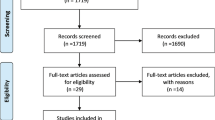Abstract
Prosthetic mesh reinforcement is now routine in the management of inguinal hernia but can cause considerable pain and stiffness around the groin. The aim of this study was to compare the outcome after laparoscopic TEP inguinal repair using new lightweight or traditional heavyweight mesh performed in a single unit. Between November 2004 and March 2005, 113 patients underwent laparoscopic TEP inguinal repair using either lightweight (28 g/m2) or heavyweight (85 g/m2) mesh. Follow-up data was obtained using case note review and telephone-based questionnaire in April 2005. Follow-up information was obtained for 93 (83%) out of 113 patients. There was no difference between the two groups in the incidence of pain/discomfort at mean 3-month follow-up (45 vs 41%, Mann–Whitney U, P=0.641). However, there was a significant inverse correlation between the length of time since operation and severity of pain/discomfort in the lightweight group (P=0.001, Pearson test), suggesting a faster speed of recovery with lightweight mesh. Laparoscopic TEP inguinal hernia repair with lightweight mesh yields promising early results. Whilst there was no significant difference in pain or recurrence in the short term, post-operative pain scores improved earlier in patients with lightweight mesh compared to heavyweight mesh. This merits further study, with larger cohorts and longer follow-up, to determine the benefits of lightweight mesh.


Similar content being viewed by others
References
Hair A, Duffy K, McLean J, Taylor S, Smith H, Walker A, MacIntyre IM, O’Dwyer PJ (2000) Groin hernia repair in Scotland. BJS 87:1722–1726
Kingsnorth A, LeBlanc K (2003) Hernias: inguinal and incisional. Lancet 362:1561–1571
MRC Laparoscopic Groin Hernia Trial Group (1999) Laparoscopic versus open repair of groin hernia: a randomised comparison. Lancet 354:185–190
EU Hernia Trialist Collaboration (2002) Laparoscopic versus open groin hernia repair: meta-analysis of randomised trials based on individual patient data. Hernia 6:2–10
Hamer-Hodges DW, Scott NB (1985) Replacement of an abdominal wall defect using expanded PTFE sheet (Core-Tex). J R Coll Surg Edinb 30:65–67
DeBord JR (1998) The historical development of prosthetics in hernia surgery. Surg Clin North Am 78:973–1006
Lau WY (2002) History of treatment of groin hernia. World J Surg 26:748–759
Cobb WS, Kercher KW, Heniford BT (2005) The argument for lightweight polypropylene mesh in hernia repair. Surg Innov 12:63–39
Junge K, Rosch R, Krones CJ, Klinge U, Mertens PR, Lynen P, Schumpelick V, Klosterhalfen B (2005) Influence of polyglecaprone 25 (Monocryl) supplementation on the biocompatibility of a polypropylene mesh for hernia repair. Hernia Feb 10 [Epub ahead of print]. PMID:15703859
Holzheimer RG (2004) First results of Lichtenstein hernia repair with Ultrapro-mesh as cost saving procedure–quality control combined with a modified quality of life questionnaire (SF-36) in a series of ambulatory operated patients. Eur J Med Res 9:323–327
Post S, Weiss B, Willer M, Neufang T, Lorenz D (2004) Randomized clinical trial of lightweight composite mesh for Lichtenstein inguinal hernia repair. BJS 91:44–48
O’Dwyer PJ, Kingsnorth AN, Molloy RG, Small PK, Lammers B, Horeyseck G (2005) Randomized clinical trial assessing impact of a lightweight or heavyweight mesh on chronic pain after inguinal hernia repair. BJS 92:166–170
Champault G, Barrat C (2005) Inguinal hernia repair with beta glucan-coated mesh: results at two-year follow up. Hernia 9:125–130
Ferzli GS, Massad A, Albert P (1992) Extraperitoneal endoscopic inguinal hernia repair. J Laparoendosc Surg 2:281–286
Ware JE Jr, Sherbourne CD (1992) The MOS 36-item-short-form health survey (SF36). 1. Conceptual framework and item selection. Med Care 30:473–483
Bringman S, Wollert S, Osterberg J, Heikkinen T (2005) Early results of a randomized multicenter trial comparing prolene and VyproII mesh in bilateral endoscopic extraperitoneal hernioplast (TEP). Surg Endosc 19:536–540
Beattie GC, Kumar S, Nixon SJ (2000) Laparoscopic total extraperitoneal hernia repair: mesh fixation is unnecessary. J Laparoendosc Adv Surg Tech A 10:71–73
National Institute for Clinical Excellence (2001) Guidance on the use of Laparoscopic surgery for inguinal hernia. Technological Appraisal Guidance No. 18
Liem MS, van Steensel CJ, Boelhouwer RU, Weidema WF, Clevers GJ, Meijer WS, Vente JP, de Vries LS, van Vroonhoven TJ (1996) The learning curve for totally extraperitoneal laparoscopic inguinal hernia repair. Am J Surg 171:281–285
National Institute for Clinical Excellence (2004) Guidance on the use of Laparoscopic surgery for inguinal hernia. Technological Appraisal Guidance No 83
Kumar S, Wilson RG, Nixon SJ, Macintyre IMC (2002) Chronic pain after laparoscopic and open mesh repair of groin hernia. BJS 89:1476–1479
Courtney CA, Duffy K, Serpell MG, O’Dwyer PJ (2002) Outcome of patients with severe chronic pain following repair of groin hernia. BJS 89:1310–1314
Bay-Nielsen M, Perkins FM, Kehlet H (2001) Pain and functional impairment 1 year after inguinal herniorrhaphy: a nationwide questionnaire study. Ann Surg 233:1–7
Author information
Authors and Affiliations
Corresponding author
Additional information
This study has been presented in abstract form at the British Hernia Society Conference 2005, Edinburgh.
Rights and permissions
About this article
Cite this article
Khan, L.R., Kumar, S. & Nixon, S.J. Early results for new lightweight mesh in laparoscopic totally extra-peritoneal inguinal hernia repair. Hernia 10, 303–308 (2006). https://doi.org/10.1007/s10029-006-0093-3
Received:
Accepted:
Published:
Issue Date:
DOI: https://doi.org/10.1007/s10029-006-0093-3




